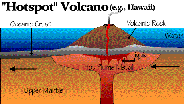

 |
Locations of Volcanoes We currently think that hot spots
are caused by plumes that rise from the lower mantle. Remember that not all of the
Earth's internal heat is transported by mantle convection, but that part is
transported by plumes of very hot rock. Experimental and computer models suggest that when
a plume reaches the lithosphere, the plume flattens out against the bottom of the
lithosphere, heats it, and causes it to bulge and fracture. Decompression melting converts
some of the plume material to lava that rises through cracks to the surface to form a huge
flood basalt volcano. Later, as the plate continues to move over the hot spot, the
"head" of the plume is sheared off, leaving the narrower hot "tail."
Lava rising up the tail and through the plate over a long period of time leaves a trail of
shield volcanoes leading away from the huge flood basalt deposit. Since the lavas
come from the mantle, the plumes are basaltic in composition and low in dissolved gases.
Plumes come in all different sizes and can occur anywhere. We currently think that hot spots
are caused by plumes that rise from the lower mantle. Remember that not all of the
Earth's internal heat is transported by mantle convection, but that part is
transported by plumes of very hot rock. Experimental and computer models suggest that when
a plume reaches the lithosphere, the plume flattens out against the bottom of the
lithosphere, heats it, and causes it to bulge and fracture. Decompression melting converts
some of the plume material to lava that rises through cracks to the surface to form a huge
flood basalt volcano. Later, as the plate continues to move over the hot spot, the
"head" of the plume is sheared off, leaving the narrower hot "tail."
Lava rising up the tail and through the plate over a long period of time leaves a trail of
shield volcanoes leading away from the huge flood basalt deposit. Since the lavas
come from the mantle, the plumes are basaltic in composition and low in dissolved gases.
Plumes come in all different sizes and can occur anywhere.All of this should sound familiar. Virtually all of these model predictions match features seen in hotspot volcanism, which is why the plume model is the leading hypothesis for hotspot volcanoes.
(Now all you have to do is figure out the probability of that actually happening in your lifetime!)
[ Locations of Volcanoes: page 1 / page 2 / page 3 / page 4 ] [ Home ] [ Teacher Pages ] [ Modules & Activities ] |
HTML code by Chris Kreger
Maintained by ETE Team
Last updated October 01, 2010
Discuss Exploring the Environment!
Some images © 2004 www.clipart.com.
Privacy Statement and Copyright © 1997-2004 by Wheeling Jesuit University/NASA-supported Classroom of the Future. All rights reserved.
Center for Educational Technologies, Circuit Board/Apple graphic logo, and COTF Classroom of the Future logo are registered trademarks of Wheeling Jesuit University.